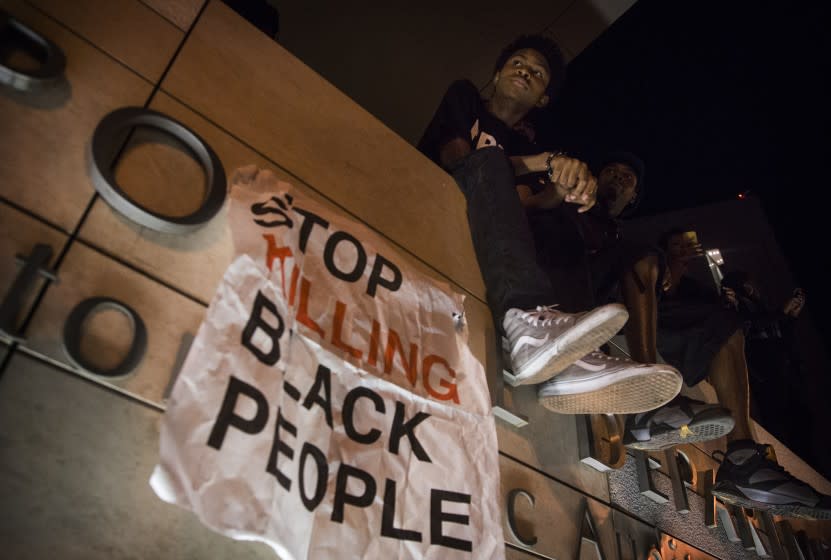Op-Ed: Trump and the Supreme Court have gutted the legal tools for fighting police abuse

Police departments rarely reform themselves, and unfortunately, under President Trump, the legal tools to deal with excessive police force and change policing have been gutted.
Twenty years ago, a group of civil rights lawyers and I did a study of the Los Angeles Police Department in the wake of the Rampart scandal and concluded that only external intervention and oversight could change a police culture that exalted Dirty Harry and shunned Serpico. The United States Department of Justice informed the city that it was going to sue for a pattern and practice of civil rights abuses, and a settlement was ultimately reached that made a significant difference in Los Angeles policing.
But the Trump Justice Department has disavowed use of this legal tool. A federal statute, 42 U.S.C. §14141, allows the Justice Department to sue a city for a pattern and practice of civil rights violations. Often these suits have led to consent decrees that mandate change. In the Los Angeles agreement, for example, hundreds of reforms were required, including monitoring of police stops and tracking of officers’ disciplinary violations. Similar successful settlements were reached in numerous cities, including Seattle, Baltimore, Pittsburgh and Cincinnati.
But in November 2018, then-Atty. Gen. Jeff Sessions made clear that he regarded section 14141 as an intrusion on local police departments and he did not want the Justice Department to enter into consent decrees for reforms. Atty. Gen. William Barr has continued that approach. The law can mandate reforms that help prevent killings like that of George Floyd, but it is now going unused.
Lawsuits are another avenue that can lead to police department reform. But the Supreme Court has made these enormously difficult. One pivotal case was City of Los Angeles vs. Lyons, in 1982, in which the court made it very hard to sue police departments for injunctions to bring about reforms. Adolph Lyons, a 24-year-old African American man, was stopped by Los Angeles police officers for having a burned-out taillight on his car. An officer slammed Lyons' hands above his head on the roof of the car, and Lyons complained that the keys were cutting into his hand. The officer then administered a chokehold on Lyons and rendered him unconscious. He awoke spitting blood and dirt. He had urinated and defecated. The officer gave him a ticket and allowed him to go.
Lyons did not want to let the matter die. He discovered that, at the time he was pulled over, 16 people in Los Angeles had already died from police use of chokeholds. Almost all of them were African American men. Lyons sued for an injunction to stop police from using the chokehold except where necessary to protect an officer’s life or safety. The Supreme Court, though, ordered his case dismissed, saying that Lyons could not show that he personally was likely to be choked again in the future. The court said that a plaintiff, like Lyons, seeking an injunction must demonstrate a likelihood of personal injury. This makes it enormously difficult, and often impossible, to sue police departments to halt use of dangerous practices like racial profiling or the restraint procedures that killed Eric Garner and George Floyd.
The Supreme Court has also made it extremely difficult to successfully sue cities or police departments for money damages, which can help to provide an incentive for reforms. The court has held that local governments can be held liable only if it is proven that their policies led to a constitutional violation. And the court has made proving municipal policy enormously difficult. Rarely can inadequacies in hiring or training or supervision or discipline rise to the level of a municipal policy.
Suing individual police officers for money damages, even when they use excessive force, also is exceedingly difficult. Any government official sued for a constitutional violation can assert a “qualified immunity” defense, which means that he or she can be held liable only for violations of clearly established law that every reasonable officer should know. The Supreme Court has said that this defense “protects all but the plainly incompetent or those who knowingly violate the law.” In case after case involving police excessive force, including deaths at the hands of the police, the Supreme Court has ordered dismissal of suits based on qualified immunity.
The result of all of this is to largely eliminate the legal tools that can be used to reform police departments. The Trump administration won’t use the federal statute that would give the Justice Department the ability to take action, and the Supreme Court has closed the courthouse doors. It is no surprise then that police abuses continue and that the nation has erupted over the racism in policing that is so deeply embedded in American history.
It does not have to be this way. The Justice Department could go back to using its authority under Section 14141. Congress could revise federal civil rights statutes to provide more ways to challenge and reform police departments. The Supreme Court could reevaluate the legal doctrines that make suits against police so difficult. Dramatic changes in police departments can occur, but only if there are the legal tools to make it happen.
Erwin Chemerinsky is dean of the UC Berkeley School of Law and a contributing writer to Opinion.

